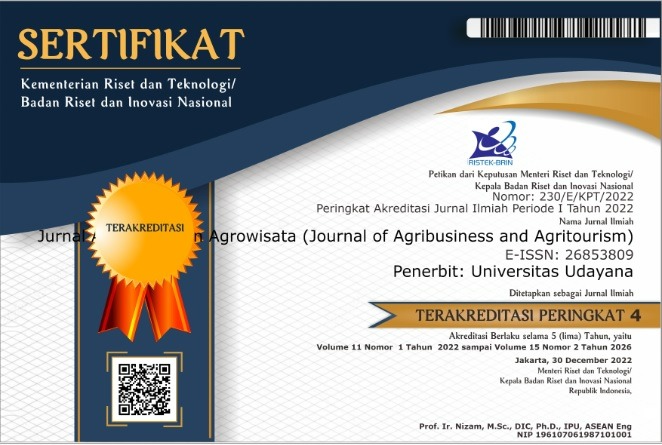Daya Saing Kopi Arabika Bali Sebagai Komoditi Ekspor
Abstract
Competitiveness of Bali Arabica Coffee as an Export Commodity
This study aims to examine the competitiveness of Balinese coffee from comparative advantage, and identify factors supporting the competitiveness of Balinese Arabica coffee. The research location was carried out in Catur Village, Kintamani District, Bangli Regency. Determining the location of research with a purpose method. Comparative advantage is seen from the value of the RCA index and competitive advantage is identified based on the Berlian Porter approach. The results of the analysis show that Bali coffee has low comparative competitiveness as shown by the RCA value of Bali coffee for 5 consecutive years < 1. There are several factors that can increase the competitive advantage of Balinese Arabica coffee, according to Berlian Poter's approach, including: 1. Intermediate factor requirements other natural resources that support Bali Arabica coffee to become IG products. Experienced human resources more than 20 years. 2. Demand from foreign markets has decreased due to covid but the domestic market has increased rapidly. 3. Competition between coffee-producing countries makes each producer have to maintain the quality of its product. 4. There are many government roles related to regulations from upstream to downstream industries. The conclusion that can be drawn is that although the comparative advantage of Balinese coffee has low competitiveness, it will be covered by competitive advantages, especially Bali Arabica coffee which has a very good taste which has been registered as a Geographical Indication product.
Downloads
References
Badan Pusat Statistika Indonesia. 2021. Statistik Kopi Indonesia 2021. Jakarta. BPS Indonesia.
Badan Pusat Statistik Provinsi Bali. 2021. Statistik Daerah Provinsi Bali. Denpasar. BPS Provinsi Bali.
Baso, R. L., dan Anindita, R.2018. Analisis Daya Saing Kopi Indonesia Analysis. Ekonomi Pertanian dan Agribisnis Jurnal Ekonomi Pertanian Dan Agribisnis (JEPA), 2(1), 1–9.
Fairuz, Machariri Rifa. 2022. Pengaruh Inflasi dan Nilai Tukar Terhadap Nilai Ekspor Indonesia Ke Cina. Skripsi Program Studi Keuangan dan Perbankan D4, Fakultas Akuntansi, Politeknik Negeri Jakarta. Di akses pada https://repository.pnj.ac.id/.
Irawan, Ade. 2021. Pilihan Kopi Kintamani Bali yang Paling Populer. Berita Online. https://www.sehatq.com/review/pilihan-kopi-kintamani-bali
Izzah, S.N. Peran Asosiasi Eksportir dan Industri Kopi Indonesia (AEKI) dalam Meningkatkan Mutu dan Daya Saing Ekspor Kopi Indonesia di Pasar Eropa. JOM FISIP, 7(2),1-16. https://jom.unri.ac.id/index.php/JOMFSIP/article/download/28217/27193
Kementrian Perdagangan Republik Indonesia. 2018. Specialty Kopi Indonesia. Warta Ekspor. Edisi Pebruari.
Purwito, Ali dan Indriani. 2015. Ekspor, Impor, Sistem Harmonisasi, Nilai Pabean dan Pajak dalam Kepabean. Mitra Wacana Media. Jakarta.
Sukiada, N. W. R. P., dan Parameswari, A. A. A. I. 2020. Nation Branding Kopi Arabika Kintamani (Studi Kasus: Kopi Gunung Catur, Desa Catur, Kintamani, Bangli). SOCA: Jurnal Sosial, Ekonomi Pertanian, 14(1), 180. https://doi.org/10.24843/soca.2020.v14.i01.p15
Viforit, A. 2018. Analisis Keunggulan Kompetitif Dan Komparatif Kopi Arabika Di Kabupaten Bener Meriah. Tesis. Program Studi Magister Agribisnis, Fakultas Pertanian, Universitas Sumatera Utara Medan. https://repositori.usu.ac.id/handle/123456789/15716
Yulia, S., dan Chandriyanti, I. 2021. Analisis Daya Saing Komparatif dan Kompetitif Ekspor Komoditas Batu Bara Tiga Negara Berkembang (Indonesia, Afrika Selatan dan Kolombia). Ecoplan, 4(2), 99–110. https://doi.org/10.20527/ecoplan.v4i2.339







